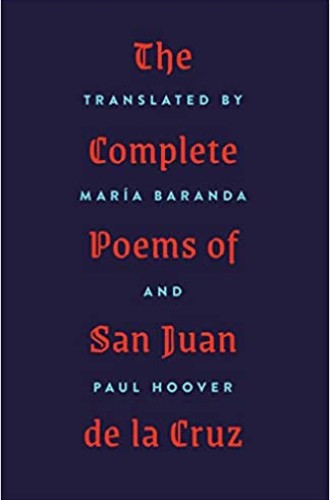A new translation of “The Dark Night of the Soul” thrills with adventure
In St. John of the Cross’s poetry, the dark night is also a night of profound, even ecstatic beauty.
Among the most famous friendships in the history of Christianity is the one between Teresa of Ávila and her fellow Carmelite, Juan, later known as San Juan de la Cruz (or most commonly in English, Saint John of the Cross). The two met in Medina del Campo, Spain, in the mid-1500s, and Teresa convinced Juan to join her movement to reform the Carmelites in a mystical and ascetic direction.
The reform-oriented Carmelites were called the Discalced (Barefoot) Carmelites. The Calced (Shoed) Carmelites felt so threatened by them that they went to extraordinary measures to stop their progress. When Teresa was elected prioress of the convent at Ávila, her superiors went on a rampage. The provincial (a local supervisor of the Carmelite Order) declared the election void and instituted his own leader for Teresa’s priory. After that, things went badly for Juan, who was arrested and transported to a prison in Toledo on the property of a Carmelite monastery. In prison, he lived in a locked cabinet, too small for him to stand up fully. He was beaten and starved.
But one night, he heard a popular love song being sung on the street. A new jailer allowed him access to pen and paper, and he started writing the two most famous of his poems, “Noche oscura” (“Dark Night”) and “Cántico espiritual” (“Spiritual Canticle”). Soon after, Juan began plotting his escape, turning his rugs into a ladder and then, day by day, loosening the screws that held his cell door closed. When he was ready, he pushed open the door, lowered his ladder, and climbed out the window, landing perilously close to a cliff over the Tagus River.
“Noche oscura,” then, is not only a mystical poem about the soul’s journey toward God through the unknown. It is also a record of Juan’s escape from jail:
In the dark, and secure,
disguised by a secret ladder,
oh, what good fortune!,
dark and hidden,
my house already at rest.
After his dramatic escape, Juan spent time in a hermitage in Andalusia, where he finished “Spiritual Canticle” and began his 400-page prose commentary on “Dark Night.”
“Dark Night,” as translated by María Baranda and Paul Hoover in this new edition, thrills with the adventure of it all—the soul’s adventure, Juan’s adventure. You can feel Juan’s delight in his newfound freedom, even in the midst of tremendous uncertainty. The night is not terrifying. It is “blissful,” it is “kinder than the dawn.” Juan is guided by an inner light that leads him without faltering to his beloved.
In all our talk about the “dark night of the soul,” we forget that in Juan’s poetry the dark night is a night of profound, even ecstatic beauty. It isn’t a state of crisis that is forced on us; it is one actively chosen in order for the soul to find the beloved.
All of Juan’s poetry explores the love relation between humankind and God, using the Song of Songs as its root text. For Juan, these images are everything. “Spiritual Canticle” is a song between “the soul and the husband.” In various poems, Juan plays with the genders of his lovers, sometimes taking on a male and sometimes a female persona. He occupies the voices of the seeker and the sought. Many of his later poems are classic romances, full of longing and intimacy. Popular songs called villancicos provide the form that Juan often uses.
Just as Juan plays with male and female, he also constantly plays with other inversions and reversals. He is a master of paradox. Dark is light. Night is day. Silence is speech. Lost is found. Death is life. This translation feels sometimes a bit like reading the Tao Te Ching:
To come to know everything
Don’t want to know something of nothing . . .And when you come to have everything,
Have it with nothing to have.
But despite the constant play of negative theology, Juan’s poetry bursts with song and dance. It sounds like it is meant to be sung on the street. (The Spanish version is on the page facing each translation.) In a section titled “Romances,” Juan considers the incarnation, which he calls the advent of the Verb, not the Word. “In the beginning resided,” he writes, “the Verb, and it lived in God, / in whom it possessed / its infinite happiness.”
Why choose the word Verb? Hoover suggests that this is because Juan embraced a far more active theology than nouns allow. While we often think of mysticism as non-doing, Juan’s mystical lovers are actively searching for one another and actively finding.
We are included in this activity. In a short poem called “Of the Divine Verb,” Juan writes,
Pregnant with
the Divine Verb
the Virgin comes this way,
will you give her shelter?
In the context of Juan’s poetry, there is really only one verb with which the Virgin could be pregnant, and that is love. The English word love has the benefit of being simultaneously a noun and a verb. If the Virgin is pregnant with love, then that is both the action and the substance. If we welcome her, offer her posada, as the Spanish calls it, then we are responding to love with love, just as the Trinity does.
Trying to describe the Trinity and the Divine Verb at once, Juan writes,
And into one love in all of them
and a lover made them;
and the lover is the beloved
in which each one lived.
The beloved, Juan explains, is not any one of the three persons alone but the love that the three share, “Three Persons and one Beloved.” Thus, love is not only action and substance, but also shelter and object. That’s a lot for one little word.






